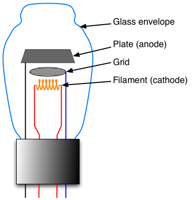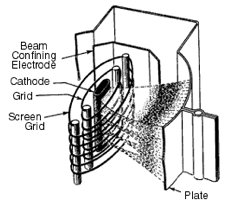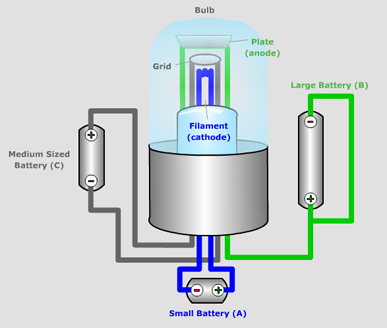The traditional amplification valves are all based on the triode. A triode usually consists of following parts (See the graph on the right).
- Cathode (K) or Filament (F)
- Anode (P), also known as the plate
- Control Grid (G)
Basically, the cathode is heated up by the filament to a sufficient temperature at which it releases free electrons into the space around it. These free electrons are then pulled towards the anode by the electric field between the cathode and anode.
By introducing the control grid, the plate current can be manipulated. When negative, it repels the electrons coming from the cathode by producing an opposing electric field against the anode. As a result the current flow between the anode and the cathode is reduced. In this case, the grid draws no current. When a positive voltage is applied, however, it enhances the electric field so more electrons can reach the anode. Now the grid draws a small current itself but it is considered negligible.
In order to limit the plate current, so it never reaches saturation, the grid is usually negatively biased. The grid sensitively controls the large plate current by drawing a small but negligible current, so it makes the vacuum tube a very powerful current amplifier.
To further improve the performance, additional electros, the screen grid and the suppressor are mounted into the triode. For more details please see the main report, chapter 1.
For further readings to go the main report - Principle of Operation.
Click on the picture below to view a full flash animation:
Further Readings/ References:
1. Calvert, J. B. (2001) Vacuum Tubes. http://mysite.du.edu/~etuttle/electron/elect27.htm
2. Flash animation from: http://www.edumedia-share.com/media.php?id=882

